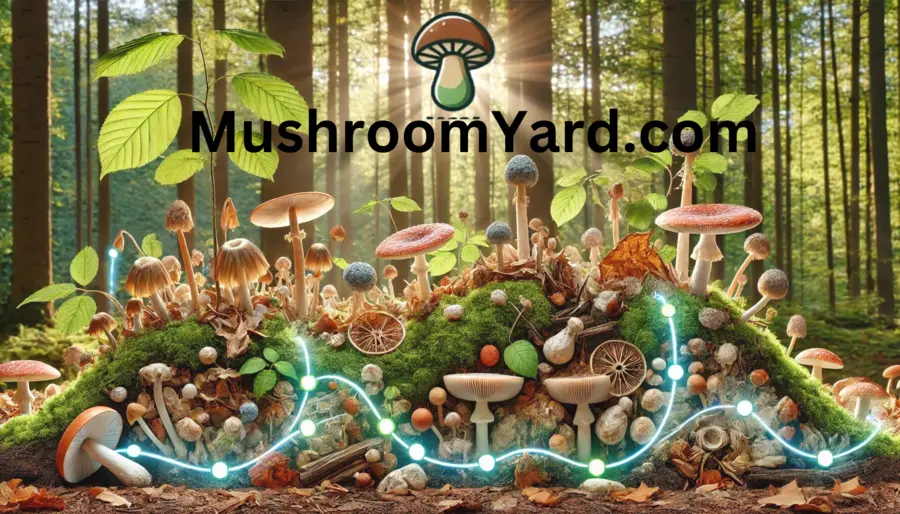

Unlike plants that rely on sunlight for energy, mushrooms have a different approach. The question, “Where do mushrooms get their energy from?”, leads us deep into the natural world’s recycling system—where decomposition is king and fungi rule the stage.
Mushrooms get their energy from decomposing organic matter. They are fungi, and unlike plants, they do not photosynthesize. Instead, they break down complex organic materials, such as dead plants, wood, leaves, and other organic debris, into simpler compounds. Mushrooms absorb nutrients and energy through their mycelium, a network of thread-like structures (hyphae) that penetrate the material they are decomposing.
The mycelium releases enzymes that break down complex molecules like cellulose and lignin found in plant matter. Once broken down, the mushroom absorbs the simpler nutrients, which fuel their growth and reproduction. This makes mushrooms essential decomposers in ecosystems, helping recycle nutrients back into the soil.
Even, mycelium produces waste after it breaks down nutrients in its environment. Those are known as Mycelium piss.
Mycelium Piss – Yellow Liquid on Mushrooms
Let’s discuss this in detail.
First, let’s clear up a common misconception: mushrooms are not plants. They belong to the fungi kingdom, a separate branch of life altogether. While plants generate their own energy via photosynthesis—converting sunlight, water, and carbon dioxide into food—mushrooms lack chlorophyll, the green pigment responsible for this process. So, how do they get the energy they need to grow and thrive?
Mushrooms are saprotrophic organisms, meaning they derive energy from breaking down dead organic material. They are the ultimate recyclers in nature, working silently to convert dead trees, leaves, and other organic matter into nutrients that can be absorbed by the environment.
At the heart of this energy transfer is the mycelium, a web-like structure of thread-like fibers called hyphae. Mycelium spreads through the material the mushroom is feeding on, secreting enzymes that break down tough organic compounds like cellulose, lignin, and hemicellulose—the building blocks of plant material.
These complex compounds are broken down into simpler molecules like sugars, which the mushroom absorbs for energy and growth. Imagine the mycelium as the underground roots of the mushroom, constantly working to find and process food from the world around it.
The real heroes in this process are the enzymes secreted by the mycelium. Different mushrooms produce different types of enzymes depending on the material they are decomposing. For instance, white rot fungi, such as certain species of oyster mushrooms, can break down lignin—the tough compound that gives wood its rigidity. Other mushrooms may specialize in digesting fallen leaves or animal waste.
Once these enzymes break down the material into smaller molecules, the nutrients are absorbed into the mushroom’s hyphae and used to fuel its growth, reproduction, and eventual formation of the visible mushroom cap that we’re all familiar with.
Mushrooms play a pivotal role in nutrient cycling. By breaking down organic matter, they release nutrients such as carbon, nitrogen, phosphorus, and potassium back into the soil. These nutrients are then available for plants to absorb, creating a continuous loop of life, death, and renewal.
Without mushrooms and other fungi, the forest floor would be buried in fallen trees, leaves, and plant debris. But thanks to their efficient recycling abilities, mushrooms ensure that ecosystems remain healthy and balanced, creating fertile soil for future plant growth.
Not all mushrooms are content with decomposing dead matter—some are a little more ambitious. Certain types of mushrooms, known as parasitic fungi, tap into living organisms for their energy needs. For example, honey mushrooms (Armillaria) can infect trees, causing them to rot from the inside. While this might sound harmful (and it can be), it’s all part of nature’s balance.
Other mushrooms form symbiotic relationships with plants in a mutually beneficial arrangement. These mushrooms are known as mycorrhizal fungi. The mycelium of mycorrhizal fungi wraps around plant roots, extending the plant’s reach to absorb water and nutrients more efficiently. In return, the fungus gets some of the sugars produced by the plant. Examples of such mushrooms include truffles and many species of wild forest mushrooms.